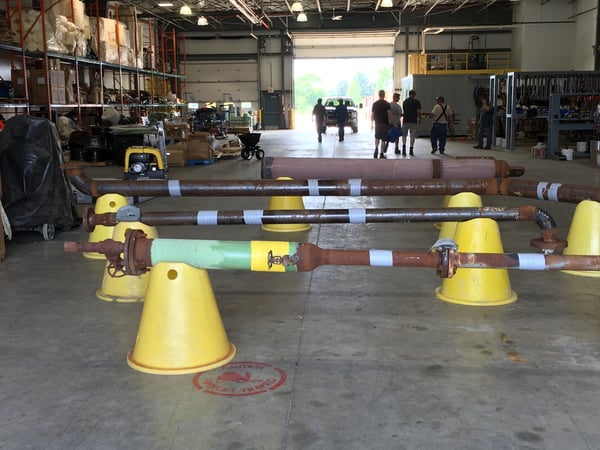From cooking and heating to electricity production to industrial manufacturing, natural gas plays a...
What is a Manufacturer’s Qualified Application Procedure?
 Applicators and contractors working in the water, oil, and natural gas industries rely upon the Manufacturer's Qualified Application Procedures (MQAP) for their documented quality management systems. The MQAPs contain pertinent instructions specific to the manufacturer's coating systems and agency standards and regulations. One such agency that requires MQAPs is the Canadian Standards Association (CSA Group).
Applicators and contractors working in the water, oil, and natural gas industries rely upon the Manufacturer's Qualified Application Procedures (MQAP) for their documented quality management systems. The MQAPs contain pertinent instructions specific to the manufacturer's coating systems and agency standards and regulations. One such agency that requires MQAPs is the Canadian Standards Association (CSA Group).
The CSA Group brings together volunteers representing varied viewpoints and interests to develop standards for a variety of industries, including pipeline coatings. While the CSA Group administers the process and establishes rules to promote fairness in achieving consensus, the Group does not independently test, evaluate, or verify products meet the content of their standards.
In October 2014, the CSA Group launched the Z245.30–18. Field-Applied External Coatings for Steel Pipeline Systems, which "covers the qualification, application, inspection, testing, handling, and storage of materials required for coatings applied externally to steel piping in the field or a shop. Coated piping addressed by this Standard is intended primarily for buried or submerged service in oil or gas pipeline systems."
 Image:MQAP training station - Chatham, Ontario.
Image:MQAP training station - Chatham, Ontario.
CSA's Standard Systems include:
- FC1: Liquid-applied or fusion bond epoxy (FBE) with a glass transition temperature of up to 115 °C (239 °F)
- FC2: Liquid-applied or FBE with a glass transition temperature of 115 °C (239 °F) or greater
- FC3: Liquid-applied or FBE intended for abrasion service
- FC4: Adhesive and a polymeric backing (e.g., tape, heat-shrinkable sleeve)
- FC5: Epoxy primer, adhesive, and a polymeric backing (e.g., tape, heat-shrinkable sleeve)
- FC6: Anti-corrosion coating, if applicable [see Items (a), (b), (d) and (e)], polyurethane foam insulation, and a polymeric backing with or without adhesive (e.g., tape, heat-shrinkable sleeve)
- FC7: Fibre-reinforced petrolatum, paraffin-filled, or visco-elastic systems
To comply with the Standard's requirements for quality, each manufacturer shall have a method of correlating the coating system identifier to their manufacturer's qualified application procedure.
MQAPs address the following:
- Tools, equipment, and consumables required to apply the coating system
- Approved solvents or other cleaning agents to clean the steel and adjacent anti-corrosion coating before surface preparation
- Surface preparation of the steel (including final surface profile, materials, and surface contamination mitigation)
- Surface preparation of adjacent anti-corrosion coatings (e.g., cutback, repairs)
- Compatibility with other anti-corrosion coatings
- Preheat methods
- Substrate temperature range for surface preparation, application, and cure
- Ambient conditions considering dew point temperature
- Coating mixing and thinning procedures
- Coating thickness range
- Coating application method
- Coating curing or cooling schedule and conditions
- Recoat and repair method
- Time to backfill
- Handling and storage requirements for coating materials, including the following, as applicable:
- Temperature limitations (e.g., freezing, excessive heat)
- Humidity
- Protection from the elements (e.g., snow, rain, sunlight)
- Protection from contaminants (e.g., dust, water, chemicals)
- Expiration date
- Protection from physical damage
Both the manufacturer and the application company are required to have a documented quality management systems. The manufacturer is responsible for the quality of the materials and the application procedure. Whereas the application company is accountable for the quality of the coating system's application, and ensuring that only qualified personnel apply the products. Tapecoat, Royston and other manufacturers typically work with local partners to provide required MQAP training sessions at the applicator's facility.
Certificate of applicator qualification
A certificate of applicator qualification will be issued to the participating individuals upon successful completion of the training session. The document states the following:
- Applicator's name
- Coating system(s) for which the applicator is qualified
- MQAP used to train the applicator
- Date of qualification training
For traceability, each certificate includes a unique identifier for the qualified applicator. A record of the document is retained by the applicator, the application company, and the manufacturer. These certificates are also available upon request of the Utility company. In instances where the Utility company and the application company are the same, retention of the documents by the Utility company will suffice.
Tapecoat and Royston's MQAPs comply with the CSA's standard Z245.30-18 for Field-Applied External Coatings for Steel Pipeline Systems. For assistance in coating selection, surface preparation, application, or inspection, or to schedule an MQAP Certificate of Applicator Qualification training session, please contact a Chase Representative.
Chase Corporation's team of technical consultants are available to assist you with pipeline product information to meet your application needs. Please contact us.







